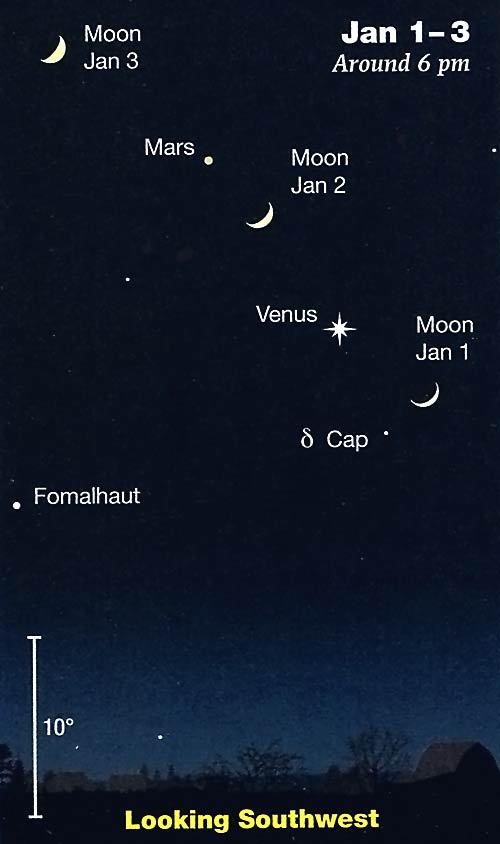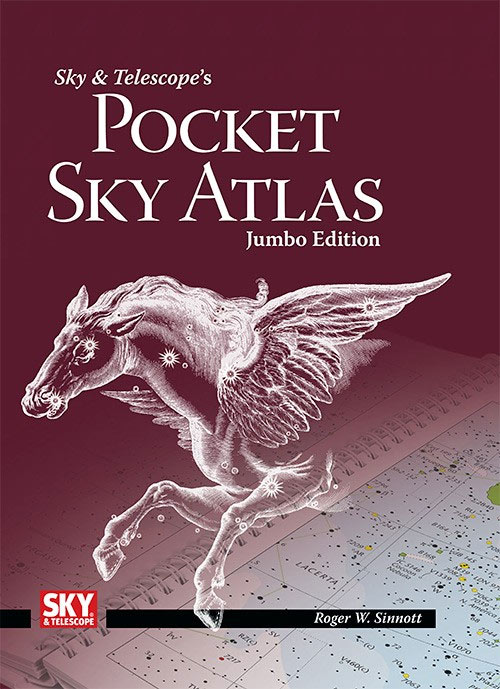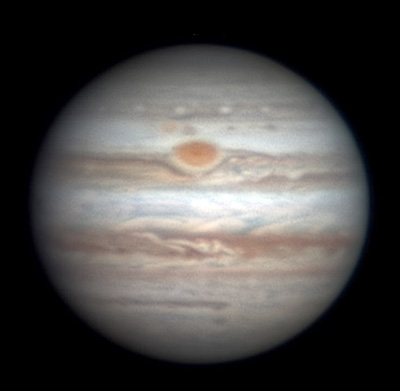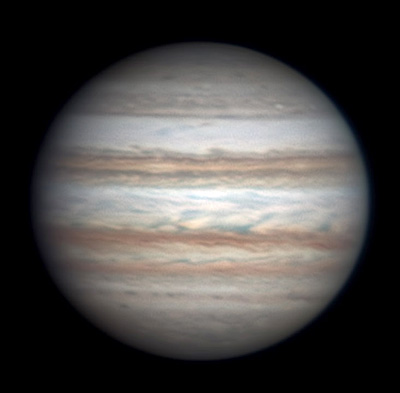Astronomy - This Week’s Sky at a Glance, December 30 – January 7
Friday, December 30
• Can you spot the fingernail-thin crescent Moon in twilight? It's less than two days old as seen after sunset from North America. Look low in the southwest 30 to 50 minutes after the Sun goes down. The Moon is about 30° (three fists at arm's length) lower right of shiny Venus.
A similar distance to the Moon's upper right sparkles Altair.
• Got a new scope for the holidays? Not quite sure what to do with it? Read What to See with Your New Telescope.
Saturday, December 31
• As twilight fades, catch the crescent Moon, Venus, and Mars forming a diagonal, gently curving line in the southwest. Left of the line twinkles Fomalhaut, 25 light-years away — the same distance as Vega, now the brightest star in the northwest.
• Mars is passing faint Neptune. They're only about 0.2° apart early this evening as seen from the East Coast of North America, and 0.1° as seen from the West Coast. Neptune, 8th magnitude, is more or less above Mars. Use high power to try to discern Neptune's slightly nonstellar disk, diameter just 2.2 arcseconds.
• After the noise and hoopla at the turning of midnight tonight, step outside into the silent, cold dark. Shining in the south will be Sirius at its very highest. The other bright stars of Canis Major are to its right and below it. Sirius forms the bottom of the bright, equilateral Winter Triangle. The triangle's other stars are Betelgeuse in Orion's shoulder to Sirius's upper right, and Procyon the same distance to Sirius's upper left. The Winter Triangle now stands upright just about in balance.

As the new year begins, watch the waxing Moon step up eastward past Venus and Mars, as seen here just after dark.
Sunday, January 1
• The waxing crescent Moon shines about 5° lower right of bright Venus in the southwest early this evening, as shown here. Modest Mars glows 12° upper left of Venus.
Monday, January 2
• The Moon poses between Venus and Mars during and after dusk, as shown here.
Tuesday, January 3
• Now the Moon stands upper left of Mars and Venus during and after dusk.
Wednesday, January 4
• In early evening at this time of year, the Great Square of Pegasus balances on one corner high in the west. The vast Andromeda-Pegasus constellation complex runs all the way from near the zenith (Andromeda's foot) down through the Great Square (Pegasus's body) to fairly low in the west (Pegasus's nose).
Thursday, January 5
• First-quarter Moon (exact at 2:47 p.m. EST). This evening, look to the right or upper right of the Moon for the Great Square of Pegasus. A diagonal through two corners of the Square points toward the Moon.
• Orion is now well up in the east-southeast after nightfall, with his three-star Belt nearly vertical. The Belt points up toward Aldebaran and, even higher, the Pleiades. In the other direction, it points down to where bright Sirius rises around 7 p.m. (depending on your location), to twinkle furiously.
Friday, January 6
• Look above the Moon this evening for the two or three brightest stars of Aries.
• This is the time of the year when Cassiopeia passes highest, just north of overhead, right after dark. When in this position, Cassiopeia is a flattened letter M.
Saturday, January 7
• Aldebaran shines well to the left of the waxing gibbous Moon this evening. Upper right of Aldebaran, spot the Pleiades through the moonlight.
• In this very coldest time of the year, the dim Little Dipper (Ursa Minor) hangs straight down from Polaris after dinnertime, as if, per Leslie Peltier, from a nail on the cold north wall of the sky.
• The Big Dipper, meanwhile, is creeping up low in the north-northeast. Its handle is very low and its bowl is to the upper right.
_________________________
Want to become a better astronomer? Learn your way around the constellations! They're the key to locating everything fainter and deeper to hunt with binoculars or a telescope.
This is an outdoor nature hobby. For an easy-to-use constellation guide covering the whole evening sky, use the big monthly map in the center of each issue of Sky & Telescope, the essential guide to astronomy.

The Pocket Sky Atlas plots 30,796 stars to magnitude 7.6 — which may sound like a lot, but it's less than one per square degree on the sky. Also plotted are many hundreds of telescopic galaxies, star clusters, and nebulae. Shown above is the new Jumbo Edition for easier reading in the night. Click image for larger view.
Once you get a telescope, to put it to good use you'll need a detailed, large-scale sky atlas (set of charts). The basic standard is the Pocket Sky Atlas (in either the original or new Jumbo Edition), which shows stars to magnitude 7.6.
Next up is the larger and deeper Sky Atlas 2000.0, plotting stars to magnitude 8.5; nearly three times as many. The next up, once you know your way around, is the even larger Uranometria 2000.0 (stars to magnitude 9.75). And read how to use sky charts with a telescope.
You'll also want a good deep-sky guidebook, such as Sue French's Deep-Sky Wonders collection (which includes its own charts), Sky Atlas 2000.0 Companion by Strong and Sinnott, or the bigger Night Sky Observer's Guide by Kepple and Sanner.
Can a computerized telescope replace charts? Not for beginners, I don't think, and not on mounts and tripods that are less than top-quality mechanically (meaning heavy and expensive). And as Terence Dickinson and Alan Dyer say in their Backyard Astronomer's Guide, "A full appreciation of the universe cannot come without developing the skills to find things in the sky and understanding how the sky works. This knowledge comes only by spending time under the stars with star maps in hand."
This Week's Planet Roundup

Jupiter's Great Red Spot side. . .

. . .and non-Red-Spot side, imaged by Christopher Go on November 30th and 27th, respectively. South is up. With Jupiter now in fine telescopic view pre-dawn, it's showing a huge white zone south of the brownish South Equatorial Belt, but nothing like that in the northern hemisphere. A very small telescope should be able to show the difference.
Mercury is hidden in the glow of sunrise for most of this week.
Venus is the bright white "Evening Star" blazing in the southwest during and after twilight. This week it's magnitude –4.5, crossing from Capricornus into Aquarius. In a telescope Venus appears about half lit and growing larger as it approaches us: it's 22 arcseconds from cusp to cusp.
When will Venus appear exactly half lit? Technically that happens on January 14th. But because sunlight skims Venus's cloudtops at a low angle near the terminator, illuminating them rather dimly, Venus appears half-lit (at dichotomy) to most observers some days earlier. When will it seem so to you? This offset is called the Schröter effect, and its history is told in the January Sky & Telescope, page 52.
Venus in a telescope is least glary when viewed in a bright twilight sky, so get your telescope on it as soon as you can see it naked-eye.
Mars (magnitude +0.9, in Aquarius) is the fainter orange "star" upper left of Venus. The separation between them shrinks from 12° to 10° this week. Look for Fomalhaut well down to their lower left. In a telescope, Mars a tiny orange fuzzblob not quite 6 arcseconds in diameter.
Jupiter (magnitude –2.0, in Virgo) rises around 1 a.m. and shines brightly high the south by early dawn. Spot Spica 5° below it. Jupiter is creamy white, but Spica is icy white with a trace of blue. In a telescope, Jupiter is 35 or 36 arcseconds in diameter, relatively small as Jupiter goes. It's still far away, heading toward opposition on April 7th.
Saturn (magnitude +0.5, in Ophiuchus) is emerging from the glow of sunrise. Look for it in early dawn very low in the southeast. You'll also find twinkly orange Antares in the vicinity, 13° to Saturn's right or upper right. Antares is magnitude +1.0.
Uranus (magnitude 5.8, in Pisces) is high in the south after dark.
Neptune (magnitude 7.9, in Aquarius) is near Mars after dusk this week. They appear closest on December 31st, 0.2° apart or less right after dark for North America, with Neptune more or less above Mars. Use high power to try to discern its 8th-magnitude disk, which with a diameter of 2.2 arcseconds appears only slightly nonstellar. Finder charts for Uranus and Neptune among their background stars.
__________________________
All descriptions that relate to your horizon — including the words up, down, right, and left — are written for the world's mid-northern latitudes. Descriptions that also depend on longitude (mainly Moon positions) are for North America.
Eastern Standard Time (EST) is Universal Time (UT, UTC, or GMT) minus 5 hours.
__________________________
"This adventure is made possible by generations of searchers strictly adhering to a simple set of rules. Test ideas by experiments and observations. Build on those ideas that pass the test. Reject the ones that fail. Follow the evidence wherever it leads, and question everything. Accept these terms, and the cosmos is yours."
— Neil deGrasse Tyson
— Neil deGrasse Tyson
No comments:
Post a Comment